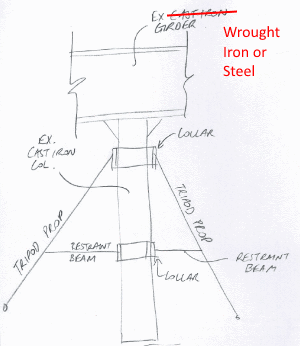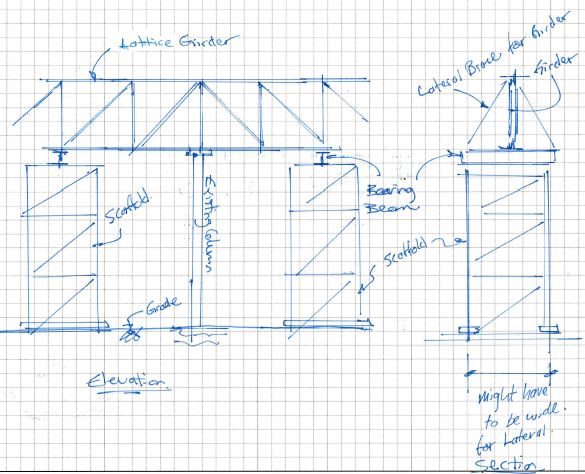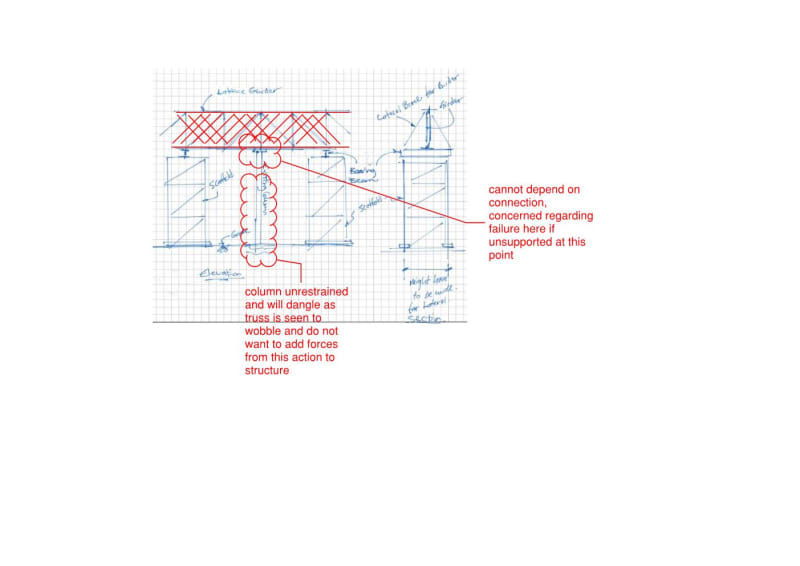gmannix1000
Structural
- Dec 6, 2010
- 21
Hi All,
Looking for peoples thoughts on this - I have a line of existing cast iron column needing to be retaining on site but existing crap foundations need to be removed and replaced by new structure. The line of columns only hold a lattice girder, unloaded, just carrying it's own self weight. Three existing columns are circular, two are channels with plates connecting them vertically at 1200c/c and one column is a I section with rivits through both sides of the flanges. See attached. Note we are trying not to bolt through or cut any existing steel because we're concerned of the ductility of the cast iron. Columns are about 5m high. Cast-iron column will become a tension column with its own self weight in the temporary case until it is supported by new structure shortly after.
To do this, I came up with a tripod propping system, attached to the underside of the lattice girder around the truss via a temporary collar clamped tight around it and propped securely to a ground embedded pad foundation. The tripod props will carry the dead load of the girder and keep the truss from moving at the top. I have another collar mid-height of the column with a tie restraint beam back to the props to stop the column dangling and potential girder rotation once the existing foundation is cut out and removed. See attached. Does anyone have any advice or encountered any similar situation or should I specify any other safe measures?
So this works for the circular cast iron columns but for the other two, I'm stumped. Anyone any ideas how I can collar/clamp to an I section with rivits and a column made up of two channels/vertical plates @1200 centres and rivits? See attached. Have to clamp/support the column at the top to stop lattice girder moving and trying to avoid drilling.
Any comments gratefully appreciated!
Looking for peoples thoughts on this - I have a line of existing cast iron column needing to be retaining on site but existing crap foundations need to be removed and replaced by new structure. The line of columns only hold a lattice girder, unloaded, just carrying it's own self weight. Three existing columns are circular, two are channels with plates connecting them vertically at 1200c/c and one column is a I section with rivits through both sides of the flanges. See attached. Note we are trying not to bolt through or cut any existing steel because we're concerned of the ductility of the cast iron. Columns are about 5m high. Cast-iron column will become a tension column with its own self weight in the temporary case until it is supported by new structure shortly after.
To do this, I came up with a tripod propping system, attached to the underside of the lattice girder around the truss via a temporary collar clamped tight around it and propped securely to a ground embedded pad foundation. The tripod props will carry the dead load of the girder and keep the truss from moving at the top. I have another collar mid-height of the column with a tie restraint beam back to the props to stop the column dangling and potential girder rotation once the existing foundation is cut out and removed. See attached. Does anyone have any advice or encountered any similar situation or should I specify any other safe measures?
So this works for the circular cast iron columns but for the other two, I'm stumped. Anyone any ideas how I can collar/clamp to an I section with rivits and a column made up of two channels/vertical plates @1200 centres and rivits? See attached. Have to clamp/support the column at the top to stop lattice girder moving and trying to avoid drilling.
Any comments gratefully appreciated!


![[idea] [idea] [idea]](/data/assets/smilies/idea.gif)


